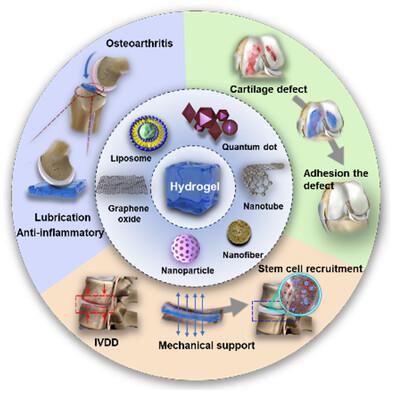Nanocomposite Hydrogels: A Promising Approach for the Treatment of Degenerative Joint Diseases
IF 11.1
Q1 MATERIALS SCIENCE, MULTIDISCIPLINARY
引用次数: 0
Abstract
Degenerative joint diseases, as a global public health issue, impose significant burdens on patients’ lives and substantial economic costs on society. Currently, the primary modalities include physical therapy, pharmaceutical intervention, and surgical procedures. None of these approaches can alter the course of this degenerative process. Due to their commendable biocompatibility, biodegradability, and heightened efficacy in drug delivery, hydrogels present themselves as a novel noninvasive remedy for degenerative joint ailments. However, the clinical application of hydrogels still faces some challenges, including the uncontrolled discharge of encapsulated medications, the absence of adequate mechanical reinforcement for destabilized joints, and adaptability to fluctuating microenvironments. Recently, nanocomposite hydrogels, formed by introducing nanomaterials into hydrogels by physical or chemical means, can improve the limitations of hydrogels and extend their potential for biological applications in degenerative joint diseases. In this study, the pathologic features of degenerative joint diseases and the multiple applications of different types of nanocomposite hydrogels in targeting these different pathologic features are briefly described. It also concludes with an outlook on the use of nanocomposite hydrogels in clinical settings and discusses their challenges and limitations.

纳米复合水凝胶:治疗退行性关节疾病的有效方法
退行性关节疾病是一个全球性的公共卫生问题,给患者的生活带来了沉重负担,也给社会带来了巨大的经济损失。目前,主要的治疗方式包括物理治疗、药物干预和外科手术。这些方法都无法改变这一退化过程。由于水凝胶具有良好的生物相容性、生物可降解性和更高的给药效率,因此是治疗关节退行性疾病的一种新型非侵入性疗法。然而,水凝胶的临床应用仍面临一些挑战,包括封装药物的不可控释放、对不稳定关节缺乏足够的机械加固以及对波动微环境的适应性。最近,通过物理或化学方法在水凝胶中引入纳米材料而形成的纳米复合水凝胶可以改善水凝胶的局限性,并扩展其在退行性关节疾病中的生物应用潜力。本研究简要介绍了退行性关节疾病的病理特征以及不同类型的纳米复合水凝胶针对这些不同病理特征的多种应用。最后还展望了纳米复合水凝胶在临床中的应用,并讨论了其面临的挑战和局限性。
本文章由计算机程序翻译,如有差异,请以英文原文为准。
求助全文
约1分钟内获得全文
求助全文
来源期刊
CiteScore
14.00
自引率
2.40%
发文量
0
期刊介绍:
Small Science is a premium multidisciplinary open access journal dedicated to publishing impactful research from all areas of nanoscience and nanotechnology. It features interdisciplinary original research and focused review articles on relevant topics. The journal covers design, characterization, mechanism, technology, and application of micro-/nanoscale structures and systems in various fields including physics, chemistry, materials science, engineering, environmental science, life science, biology, and medicine. It welcomes innovative interdisciplinary research and its readership includes professionals from academia and industry in fields such as chemistry, physics, materials science, biology, engineering, and environmental and analytical science. Small Science is indexed and abstracted in CAS, DOAJ, Clarivate Analytics, ProQuest Central, Publicly Available Content Database, Science Database, SCOPUS, and Web of Science.

 求助内容:
求助内容: 应助结果提醒方式:
应助结果提醒方式:


